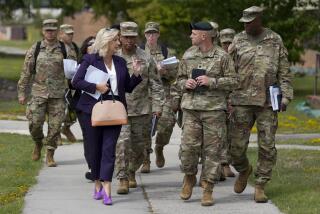U.S. Military Readiness on the Rise, Report Says
- Share via
WASHINGTON — Amid a rising political debate over the state of the U.S. military, the Pentagon on Thursday issued a report contending that readiness is improving despite persistent problems.
In a quarterly analysis for Congress, defense officials reported that current strains on readiness would increase the risk of U.S. casualties if the United States were forced to simultaneously fight two big regional wars. The ability to handle a two-front fight has been a central goal of American military planners.
Yet the report asserts that the services “remain capable of executing” the national military strategy in an emergency and claims that “the overall readiness of our forces is improving.”
Republican presidential nominee George W. Bush and running mate Dick Cheney have given prominence to the military readiness issue, charging that the Clinton administration has allowed the military to suffer from overwork, poor morale and aging equipment.
But the Pentagon report contends that two years of military spending increases have begun to relieve shortages in spare parts and cites some improvement in the services’ ability to recruit and retain personnel.
At the White House, chief spokesman Joe Lockhart insisted that the military is in better shape today than when President Bush left office in January 1993. The United States retains “the best fighting force in the world,” he said.
The quarterly report, nearly identical to one issued three months ago, said that the readiness strains could cause various problems if the armed forces were called on to fight two simultaneous wars in places such as North Korea and the Middle East.
There could be problems in logistics, intelligence, surveillance and reconnaissance. In addition, it said the troops could be vulnerable to attack by terrorists, including with germ and chemical weapons, and from “cyber attack.”
The report, reviewing the state of each of the services, says there has been some improvement in recruiting since an increase in spending for advertising. The services now are expected to meet their year-end recruiting goals, it says.
The report acknowledges that the Air Force faces shortages in many critical job skills and in spare parts. A mismatch between personnel and job skills is holding back training in some specialties, it says. The Army, likewise, has a shortage of enlisted personnel in some skill areas, as well as in officers at the captain rank.
The report cites vulnerabilities in naval aviation. In the event of a two-front war, the Navy might be unable to provide all the desired aircraft and aircraft carriers, it says.
In the face of Republican attacks, defense officials are arguing that U.S. forces are, overall, better educated, better equipped and better trained for their military jobs than they were at the beginning of the Clinton administration.
The Republican critique is “just not supported by the facts,” said one senior defense official, who asked to remain unidentified.
While the percentage of enlisted personnel who are high school graduates has been slipping in the last couple of years, it still is higher than it was in 1990: 95% of today’s troops are high school graduates, versus 93% in 1990, officials say.
Scores on the armed forces aptitude tests have risen slightly over the last decade. They average 59.7 now, versus 57.3 in fiscal 1990, and 59.0 in fiscal 1993. And officials argue that levels of education have risen among officers, 45% of whom now have advanced degrees, compared with 39% in 1990.
Defense officials contend too that their recent budgets demonstrate their commitment to improved readiness. They have budgeted an additional $150 billion for personnel costs, operations and maintenance from fiscal 1998 to 2007, they note.
More to Read
Sign up for Essential California
The most important California stories and recommendations in your inbox every morning.
You may occasionally receive promotional content from the Los Angeles Times.














